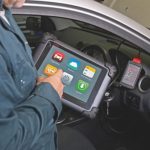Neil Kidby, Service Tool Specialist at Sealey Tools, looks back at the evolution of engine diagnostic equipment.
There was a time when vehicles did not have any form of electronic engine management system, as a motor vehicle apprentice in the 1970s it was certainly not something I even considered to be a possibility. Petrol fuel injection tended to be a mechanical system if you saw it at all in those days.
A common misconception within the independent automotive repair industry is: there will be a point where vehicle diagnostic procedures will purely be the preserve of the Franchise Dealers. Rewind to the early 1990s, diagnostic trouble codes (DTCs) were beginning to appear, workshop technicians, myself included, were all saying that the days of the independent garage being able carry out diagnostic work was coming to an end even back then!
To diagnose faults we were faced with a flashing engine warning lamp in a fashion not dissimilar to morse code, and a list of possible causes. Once we had worked out the fault code, we then had to work out what was wrong with the vehicle. Vehicle data had to be sourced from a variety of large books or manuals.
Ever-tightening emission regulations meant more complex engine management control systems were required to ensure precise fuel quantities and sparks were united in the correct place.
Despite modern vehicles being fitted with much more complex systems, diagnosing faults has actually become much easier than in those early years of electronic controls systems.
Early engine management systems relied on very basic information from a small number of sensors, around 500 calculations per second would be all that the Electronic Control Unit, (ECU) would need to ensure the engine would run correctly. Engine management is by far the most processor-intensive job on a modern vehicle, and so by nature the ECU, which can also be referred to as the Power Control Module (PCM) is the most powerful computer on most cars.
Despite modern vehicles being fitted with much more complex systems, diagnosing faults has actually become much easier than in those early years of electronic controls systems.
The ECU uses a closed-loop control system; this system monitors outputs via a network of sensors to control the inputs to the system.
A modern ECU collects data from dozens of sensors and performs literally millions of calculations per second to ensure the vehicle performs at its optimum level for performance and economy.
The ECU monitors many parameters from its various sensors; it records its own look up tables and refers back to them when calculating the best settings for optimum performance and emission output. The ECU also has to ensure the car will comply with emissions requirements for a minimum of 100,000 miles, amongst its other functions!
So, where does this leave Vehicle Technicians in today’s workshop? The answer to that is, in reality, quite a good place. Block exemption rules within EU member countries saw the introduction of a standardised OBD II connector from 2001 (2005 on diesel powered vehicles). Vehicle manufacturers also had to make their vehicle data available. This ruling allowed independent companies the means to manufacture their own fault code reading equipment.
Fault finding and diagnostic principles have never really changed and really need breaking down into three simple stages:
- Find out what the fault or issue is
- Find out how it works
- Repair it
In terms of helping to diagnose faults, diagnostic tools are simple to use and offer the independent garage very affordable solutions. The first requirement when choosing a code reader is some thought in what is required from it. For example do you need live data recording, actuation tests, adaptations and ECU coding?
In terms of helping to diagnose faults, diagnostic tools are simple to use and offer the independent garage very affordable solutions.
One of the most popular diagnostic tools Sealey offers is the MS908. This versatile unit has easy and intuitive navigation, and displays live data in text, graph, analogue and digital gauge for more than 80 vehicle makes. Among its many features it has complete capabilities for diagnostic codes, live data, actuation tests, adaptations and ECU coding. A cloud-based Data Manager saves not only the vehicle records but scanner data and technician notes as well if required.
Thankfully the days of complex and time consuming diagnostic routines are now largely in the past, yes cars have become far more complex over the last few years in both their design and function, but the equipment available to the independent garage sector has thankfully never been better.










